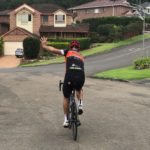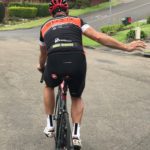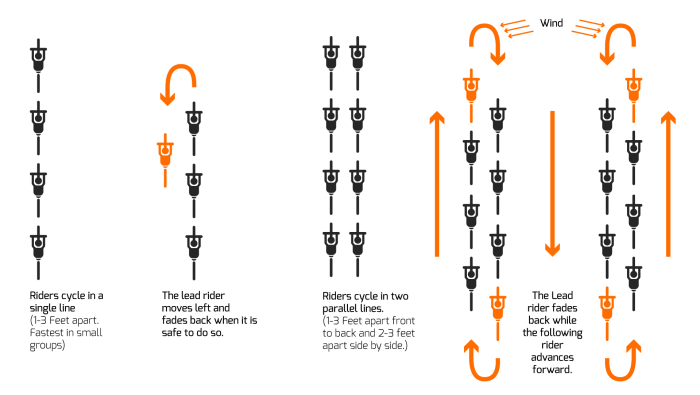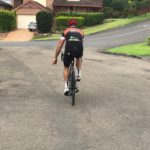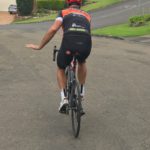WELCOME TO PACK RIDE ETIQUETTE 101
We are a large and growing club and we are regularly welcoming new riders into our rides. All riders should be tolerant, responsible riders and be willing to help educate other users within the group in a friendly manner. Being the fastest or the fittest doesn’t mean you are the King of the road or these guidelines don’t apply.
There are some basic rules and etiquette of group riding that everyone should be aware of when riding in a group. While you may have read it on the internet, or seen it on TV, nothing beats real life experience and practice. We hope that this guide will assist in promoting safe riding, increase your enjoyment on the ride with the aim of getting everyone to the coffee shop in one piece. While the guide may appear long winded, many of these actions will quickly become second nature.
When riding in a peloton your actions are no longer independent and must be considered as to their impact on the whole peloton. Everyone is responsible for the safety of the group.
GENERAL GUIDELINES
Everyone wants to get home from the ride in one piece, we are all here for fun. If this doesn’t suit you, perhaps find another group.
Ensure you have a safe and functioning bike. A well maintained bike is a safe bike.
Obey the rules of the road. Always.
Rides leave at the nominated start time.
Ride in a predictable and constant manner. Remember your actions impact everyone in the group.
Ensure you have a functioning front and rear light for riding in periods of darkness and low light. When riding in the peloton, please change your light setting to constant to assist riders riding behind you. No one wants to be blinded by a flashing light.
Be self-sufficient. Have a spare tube, water, food and correct clothing for the day.
Point out obstacles
Hold your line, especially around corners.
Repeat calls and hand signals. It is often best to relay all signals by hand. There isn’t a need for 10 people to all be yelling ‘hole’ if they are all riding in a tight formation and it is a small bit of community awareness and etiquette to not wake the neighbourhood because we are on a ride and changing lanes. The exception to this rule is when travelling at high speed where it is best to keep both hands on the handlebars and use your voice instead.
Leave the right distance to the riders in front. Roughly more than 50cm but less than a 1m between wheels. This is to leave some space for reaction times, but also not to have gaps bigger than 1m which will reduce the drafting benefit and cause the group to splinter. Never, ever, overlap wheels with the rider in front. If they change direction, that can cause a crash.
Remember that you are responsible for your front wheel.
Look forward at all times. You should not focus on the rear of the wheel of the rider in front but rather the person and the riders in front of them. By focussing on the person and the riders in front of them you will be more aware of what is happening in the bunch and give yourself more reaction time should there be an issue.
Always be ready to brake, so in a peloton the best place for your hands is on your hoods. This means no aero bars in any of our group rides.
When riding in pairs, ride in line with the person next to you. Handlebar to handlebar. Do not ‘half-wheel’ – this means always riding just in front of the person next to you.
Do your best to keep the group together. Call to “EASE UP” if you notice the group splitting or you’re struggling to maintain the pace (on group rides where this applies).
Minimise braking, and always call out to the group when doing so.
Skilled riders should be aware of less experienced riders in the bunch. For example do not ‘bunny hop’ an obstacle. You may avoid a problem but you may lead others into one.
Stopping too abruptly is dangerous and may cause an accident behind.
Do not ‘filter’ to the front of a line of stationary traffic. Keep the group together and hold the lane.
Approach all junctions where we do not have right of way by easing up and be ready to stop. This includes roundabouts and traffic lights that may change. The group may need to split if it’s a choice between this and a potential accident. Every rider must take responsibility. Just because the riders in front of you have rolled through, it does not necessarily mean it is safe for you to do so.
On an incline beware of the ‘rollback’ from the rider in front if they get out of the saddle. If you are getting out of the saddle on an incline do not stop pedalling during this action since you will fall back into the rider behind who generally has to break hard or undertake a sudden swerve. Prior to getting out of the saddle make sure you are at the top of your pedal stroke and keep the pressure on the pedal.
Help less experienced riders to learn group riding techniques and calls. We all were that new rider once.
LEAD RIDERS
Ride at a constant speed. Only ever slow down if it’s clearly signalled to the group behind first. This means that riders on the front should always be pedalling unless avoiding an obstacle or coming to a stop.Remember always that there is a long line of riders behind you riding in close proximity at high speed with little time to react. Keep all actions smooth and predictable.
When approaching a set of lights the lead riders have sole responsibility in making the call. It will either be “lights…stopping” or “rolling”.
Make safe judgements for the whole group on whether to stop at junctions, roundabouts and traffic lights. Remember that stopping abruptly will cause an accident or near-miss further back in the group.
We do not ride through red lights. When approaching a light that changes to amber the riders at the front will stop only if it’s safe to (“STOPPING”). If it is not safe to stop in such a short time call “ROLLING” to let all know that we’ll roll through.
If you aren’t comfortable, call ‘STOPPING’. Riders behind the rider who has made the call to stop, do not over rule this call.
Ease off from a standing start at a steady pace, this allows the riders at the back to not be sprinting off from every set of lights.
Make the group aware of the need to change lanes well in advance of any obstacle such as a parked car or lane ending. Don’t jump in and out of lanes unnecessarily. If you have just moved out into the middle lane because of an obstacle, don’t move back left if you have to move out again in a short distance.
Maintain the appropriate pace for the group. Ease up the pace if requested from behind to keep the group together.
Rotate off in good time to make sure the other rider can maintain the pace for the duration of their turn at the front.
BACK MARKERS
Make judgements on whether or not is it safe to change lanes.
Make the call to ‘ease up’ if they see gaps in the group forming which are not being called by others.
Call ahead to warn the group of a vehicle behind.
Call ahead (“ALL ON”) to let the front riders know the group is united.
FORMATION & ROTATION
Generally, the group formation is two abreast, but be aware of the conditions and be courteous to the vehicles we share the road with. In small groups and / or on narrow roads to let vehicles pass, there may be a need to go single file for a period. This is important to keep in mind particularly when going up a hill or at a slow pace. Otherwise we ride two abreast.
Ride formation – two abreast and then roll to the left
When required, either of the front two riders will indicate a ‘rotation’ to each other, this is generally in the form of asking the other rider ‘are you ready to roll off?’. The front-left rider will ease very slightly, and the front-right rider will pull over to the left and take over front-left position. The rider that was second in line on the right pulls up to take over front-right position.
The rider coming through does not increase the pace.
Each rider’s turn at the front depends how comfortable they are in holding the pace. On our fast group rides, the turns are only 20-30 metres long. Normal group rides turns usually last 500m – 2km depending on terrain.
VEHICLE BEHIND
On our rides we often ride on single lane roads and vehicles may approach and they may look to overtake. When a vehicle approaches from the rear of the group, the riders at the back of the group will call ‘CAR BACK’ to warn the group that a vehicle will try and pass shortly.
This is a warning to ride cautiously and hold tight formation allowing room for the vehicle to pass. Riders generally those at the back are then to consider the size of the group and the terrain and whether it would be appropriate to move into a single file.
If it considered safe and appropriate to do so the call to move into a single file, the call from the back is ‘SINGLE FILE’
OBSTACLES
It’s important that we all point out obstacles such potholes, branches, gravel, or anything that may cause an accident. This is usually indicated by a rider pointing straight down in the direction of the obstacle either side of their bike. If it’s not safe to point, obstacles make by warned vocally (such as ‘HOLE MIDDLE’, ‘GLASS LEFT’, etc)
SLOWING GROUP
If the front riders need to slow down this will be called by either ‘STOPPING’, ‘SLOWING’ or (for traffic lights) ‘LIGHTS’ calls. Usually this is accompanied by a single open palmed hand signal.
SETTING OFF
This will be indicated by ‘ROLLING’ call. The same call may be used when going through an amber light to indicate that the front riders will not stop. If you’re towards the front of the group, remember not to take off too quickly. If you’re at the back and believe the group to be rolling slowly until all ready to roll, remember to call “ALL ON” to signify the front riders can get up to normal pace
CHANGING LANES
If there is a need to change lanes, the front riders will put up their hands and call “CALL” It then becomes the back riders responsibility to determine if it’s safe to move over.
If it is safe, the riders at the back first take the lane and then call ‘OVER’ to all the riders in front – who in turn move over. If a car is passing the group, do not call ‘OVER’ until the car has passed the entire group.
If it is not safe, the riders at the back call ‘WAIT’ until it is safe to move over. Try not to use the word ‘no’ it can often sound like ‘go’, with unfortunate consequences.
MECHANICAL PROBLEM
In the event of a mechanical problem or puncture, the rider should raise their hand (if safe to do so) and call ‘MECHANICAL’. The rider and group will pull over to the side of the road as soon as it is safe.
PASSING OTHER GROUPS
When approaching a slower rider/group, the riders at the front should call out ‘RIDERS’ and ring their bell to warn the other party of our presence and give the ‘Move Right’ signal to the riders behind. Give plenty of space to riders when passing, particularly if you are in a large group moving at speed. Make sure you are well past the rider before moving back over to the left.
SUMMARY
Have fun on your ride, but keep your ego in check and your brain switched on. Group rides aren’t races, we provide plenty of opportunities to pin on a number and race. If someone is behaving inappropriately, call it out. It doesn’t matter if they are faster than you, on a better bike or seem more popular – their actions can impact us all. We all enjoy riding our bikes, so observe these guidelines and everyone’s enjoyment will increase.
Ride Safe
(these are only guidelines, there are many variations from pack ride to pack ride, just remember to communicate and never assume!)

